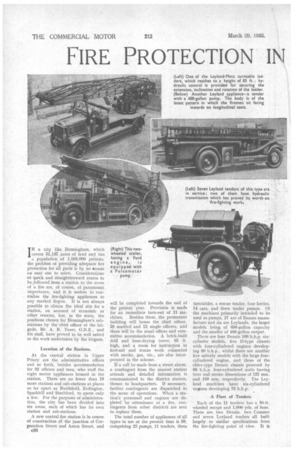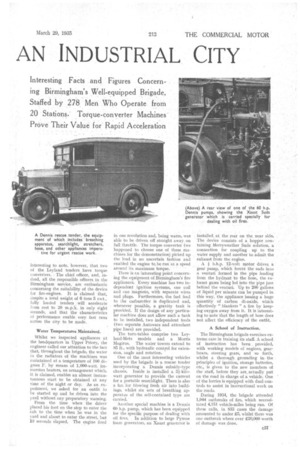FIRE PROTECTION IN AN INDUSTRIAL CITY I N a city like
Page 90

Page 91

If you've noticed an error in this article please click here to report it so we can fix it.
Birmingham, which covers 51,147, acres of land and has a population of 1,028,000 persons, the problem of providing adequate tiro protection for all parts is by no means an easy one to solve. Considerations of quick and straightforward routes to be Allowed from a station to the scene of a fire are, .of course, of paramount importance, • and it is useless to centralize the .fire-fighting appliances to any marked degree. It is not always possible to obtain the ideal site for a station, on account of economic or other reasons, but, in the main, the positions chosen for Birmingham' S substations by the chief officer Of the brigade, Mr. A. R. Tozer, O.B.E., and his staff, have proved to be well suited to the work undertaken by the brigade.
Location of the Stations.
At the central station in Upper Priory are the administrative offices and so forth, besides accommodation for 82 officers and men, who staff the eight motor appliances housed in the station. There are no fewer than 19 more stations and sub-stations at places so far apart as Northfield, Erdington, Sparkhill and Stechforcl, to quote only a few. For the purposes of administration, the city has been divided into six areas, each of which has its own station and sub-stations.
A new central fire station is in course of construction a7 the junction of Corporation Street and Aston Street, and
c36
will be completed towards the end of the present year. Provision is made for an immediate turn-out of 11 machines. Besides these, the permanent building will house the chief officer, 28 married and 12 single officers, and there will be the usual offices and committee accommodation, A brick-built drill and hose-drying tower, 85 ft. high, and a room for instruction in first-aid and rescue work connected with smoke, gas, etc., are also incorporated in the scheme.
If a call be made from a street alarm, a contingent from the nearest station attends and detailed information is communicated to the district station, thence to headquarters. If necessary, further contingents are dispatched to the scene of operations. When a station's personnel and engines are depleted by attendance at a fire, GODtin gents from other district's are sent to replace them.
The total number of appliances of all typesin use at the present time is 59, comprising 22 pumps, 11 tenders, three turntables. a rescue tender, four lorries, 14 cars, and three trailer pumps. Of the machines primarily intended to be used as pumps, 17 are of Dennis manufacture and six are Leylands, the larger models being of 650-gallon capacity and the smaller of 400-gallon output.
There are four Dennis 100 blip. sixcylinder models, five D-type chassis with four-cylindered engines developing SO b.h.p., whilst there are another five subsidy models with the large fourcylindered engine, and three of the older-type Dennis chassis powered by 60 b.h .p. four-cylincl ered units havin g bore and stroke dimensions of 127 mm. and 180 mm. respectively. The Leyland machines have six-cylindered engines developing 72 b.h.p.
A Fleet of Tenders.
Each of the 11 tenders has a 50-ft. wheeled escape and 1,000 yds. of hose. There are two Dennis, two Commer and seven Leyland tenders all built largely to similar specifications from the fire-fighting paint of view. It is interesting to note, however, that, two of the Leyland tenders have torque converters. The chief officer, and, indeed, all the responsible officers in the Birmingham service, are enthusiastic concerning the suitability of the device for fire-engines. It is claimed that, despite a total weight of 6 tons 5 cwt., fully loaded tenders . will accelerate horn rest to 20 m.p.h. in only eight seconds, and that the characteristics of performance enable very fast runs across the city to be made.
Water Temperatures Maintained.
Whilst we inspected appliances at the headquarters in Upper Priory, the engineer called our attention to the fact that, throughout the brigade, the water in the radiators of the machines was maintained at a temperature of 100 degrees F. by means of 1,000-watt. immersion heaters, an arrangement which, it is claimed, enables an almost instantaneous start to be obtained at any time of the night or day. As an experiment, we asked for an outfit to be started up and he .driven into the N,ard without any preparatory warning.
From the time when the driver placed his foot on the step to enter the cab to the time when he was in the yard and about to enter the street, but 10 seconds elapsed. The engine fired in one revolution and, being warm, was able to be driven off straight away on full throttle, The torque converter (we happened to choose one of these machines for the demonstration) picked up the load in no uncertain fashion and enabled the engine to be run at a speed around its maximum torque.
There is an interesting point concerning the equipment of Birmingham's fire appliances. Every machine has two independent ignition systems, one coil and one magneto, with separate wires and phigs. Furthermore, the fuel feed to the carburetter is duplicated and, whenever possible, a gravity tank is provided. If the design of any particular machine does not allow such a tank to be installed, two independent feeds (two separate Autovacs and attendant pipe lines) are provided.
The tarn-tablescomprise two Leyland-Metz models and a Morris Magnus. The water towers extend to 85 ft., with hydraulic control for extension, angle and rotation.
One of the most interesting vehicles used by the brigade is a rescue tender incorporating a Dennis subsidy-type chassis. Inside is installed a 31-kilowatt generator to provide the current for a portable searchlight. There is also a fan for blowing fresh air into buildings, whilst six sets of breathing apparatus of the self-contained type are carried.
Another special machine is a Dennis 60 h.p. pump, which has been equipped for the specific purpose of dealing with oil fires. In addition to large Pyrene foam generators, an Xaust generator is installed at the rear on the near side. The device consists of a hopper .containing Merryweather Suds solution, a connection for coupling up to the water supply and another to admit the exhaust from the engine. • A 1 b.h.p. 12-volt motor drivet a gear pump, which forces the suds into a venturi formed in the pipe leading from the hydrant to the hose, the exhaust gases being led into the pipe just behind the venturi, .Up to 200 gallons of liquid per minute can be pumped in this way, the appliance issuing a huge quantity of carbon di-oxide, which effectively " blankets " a fire by keeping oxygen away from it. It is interesting to note that the length of hose does not affect the efficiency of the outfit.
A School of Instruction.
The Birmingham brigade exercises extreme care in training its staff. A school of instruction has been . provided, with working models of engines, gearboxes, steering gears, and so forth, whilst a thorough grounding in,. the principles of ignition, storage batteries, etc., is given to the new members of the staff, before they are, actually put on the road in charge of a vehicle. One of the lorries is equipped with dual controls to assist in instructional work on the roads.
During 1934, the brigade attended 1,044 outbreaks of fire, which necessitated 4,151 vehicle-miles being run. Of these calls, in 833 cases the damage amounted to under £5, whilst there was one outbreak where over £20,000 worth of damage was done.




































































































































































